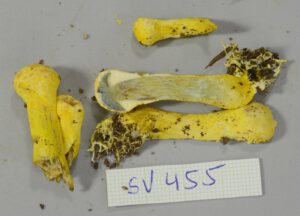Pulveroboletus fragrans Raspé & Vadthanarat, in Raspé et al., Mycological Progress 15(4/38): 4 (2016)
Index Fungorum number: IF 814679, Facesoffungi number: FoF 01917; Fig. 1
Basidiomata immature, enclosed in a mostly yellow general veil, bearing slightly viscid, pinkish orange scales on the pileus and to a lesser extent on the stipe, with olivaceous-brown fibrillose patches near the stipe base. Partial veil metablematic, cortina-like, pale yellowish white, filling the space enclosed by the general veil, between the stipe and cap. Hymenophore white, quickly and intensely bluing when cut. Pileus context yellowish white, strongly and quickly bluing when cut. Stipe context yellow marbled with white, except at the base, which is entirely yellow, slightly bluing when cut (mainly in the white areas). Basal mycelium yellowish white to yellow, cottony, with numerous rhizoids. Odour strong, aromatic. Taste not recorded.
Material examined – Thailand, Chiang Mai Province, Mae On District, Huay Kaew, on the soil in mixed Dipterocarp-Fagaceae forest, 6 June 2018, Santhiti Vadthanarat & Olivier Raspé, SV455 (CMU-SDBR).
GenBank submissions – atp6: MT468186 (CMU-SDBR SV455), ef1-α: MT468187 (CMU-SDBR SV455), rpb2: MT468188 (CMU-SDBR SV455).
Known distribution (based on molecular data) – Known only from Chiang Mai Province, Thailand.
Notes – The basidiomes found were all immature, but they exhibited the unique odour that is characteristic of the species. The identity of the collection was confirmed by the atp6 and ef1-α sequences, which were 100% identical to the sequence of the holotype. The rpb2 sequence differed only by two intra-individual heteromorphisms at positions 487 and 783. The rpb2 sequence of the holotype also contained three intra-individual heteromorphisms that were not present in SV455, at positions 7, 41, and 538. Our collection represents the second record and locality of this rare species. It was found much earlier in the rainy season than all the collections made in the other known locality, i.e., in July (Raspé et al. 2016).

Fig. 1 – Pulveroboletus fragrans (CMU-SDBR SV455). Immature basidiomes photographed in the lab.
